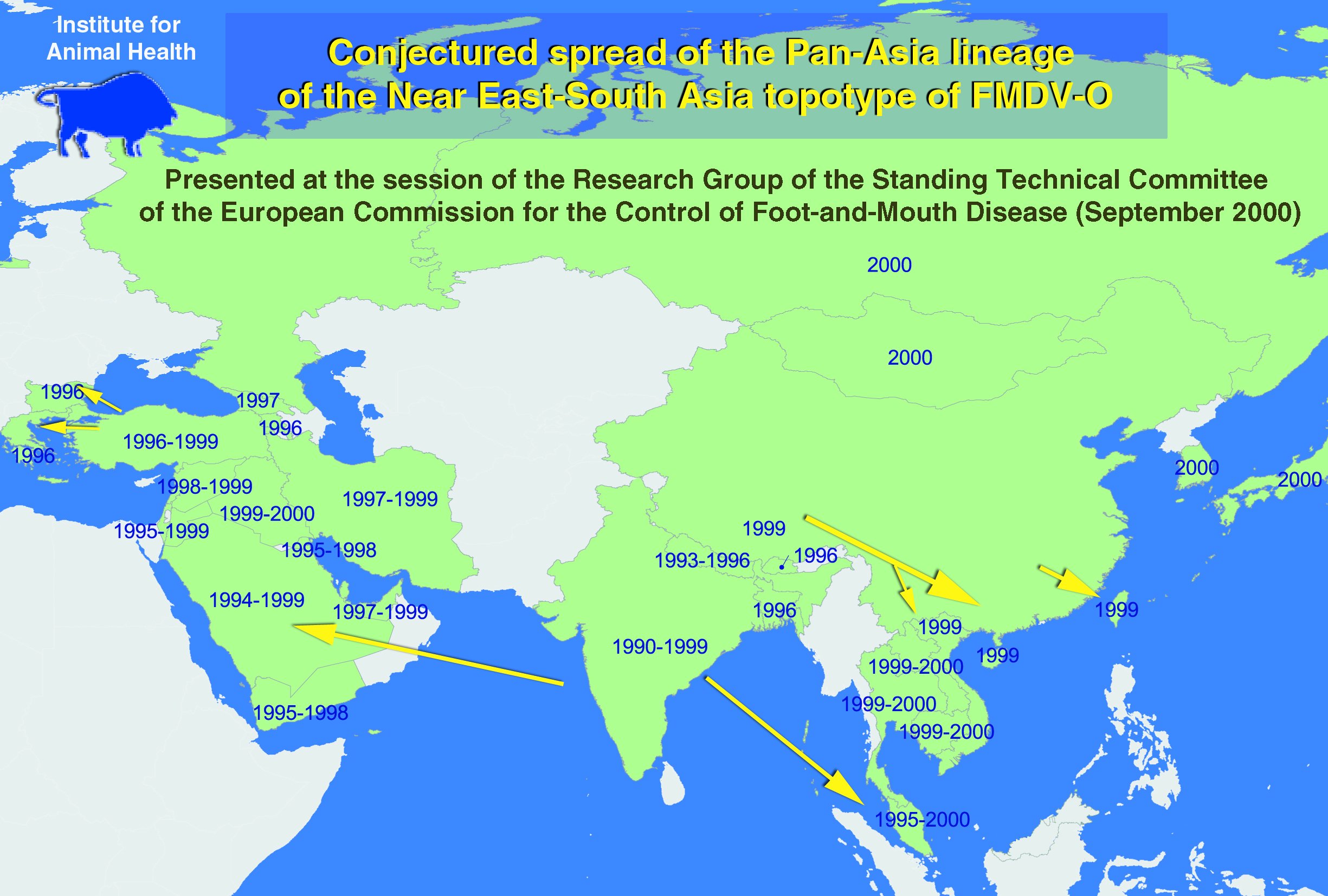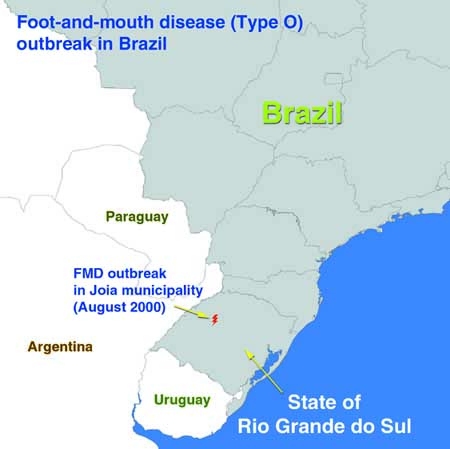


The evolution of a pandemic strain of foot-and-mouth disease virus serotype O, which has been named Pan-Asia, has recently been described. It was first identified in northern India in 1990 and spread westwards into Saudi Arabia during 1994 and, subsequently, throughout the Near East and into Europe (Turkish Thrace, Bulgaria and Greece) in 1996. In 1993 it was found in Nepal and later in Bangladesh (1996) and Bhutan (1998). In 1999, it was reported from mainland China (Tibet, Fujian and Hainan) and then detected in Taiwan Province of China. In late 1999 and in 2000 it reached most of Southeast Asia. Most recently it has been introduced into the Republic of Korea, Japan, the Primorsky Territory of the Russian Federation and Mongolia (areas free from FMD since 1934, 1908, 1964 and 1973, respectively). The virus has been isolated from a wide variety of host species (cattle, water buffaloes, pigs, sheep, goats, camels, deer and antelope).

The viruses causing these outbreaks of FMD all belong to a single genetic lineage and the nucleotide sequences of their VP1 genes differ by no more than 5 percent despite having been isolated over an 11-year period. In East Asia the strain coexisted with other strains of serotype O, particularly the pig-adapted strain which is still causing outbreaks in Viet Nam, in China, Hong Kong Special Administrative Region and in the Philippines. It is not clear why this pandemic strain of serotype O has been so successful; clinically it has caused very high mortality rates in lambs in Iraq, but has also been associated with subclinical infection in cattle in Taiwan Province of China and Japan. The rapid spread of a pandemic strain such as this clearly demonstrates the ability of newly emerging FMD viruses to infiltrate a wide geographic area and to cause epidemics in countries which have been free from the disease for many years.
In April 2000, SAT2 virus was isolated from a large dairy farm in Saudi Arabia, on which more than 30 percent of the cattle were severely affected with mortality in calves. It has spread to other dairy farms. SAT2 serotype is not one of the serotypes included in the routine vaccination in Saudi Arabia, and all the dairy cattle were totally susceptible. Genetic analysis of the Saudi isolate has shown it to be related, but not closely, to a strain previously isolated in 1998 in Eritrea. The source of the outbreak in Saudi Arabia remains undetermined at present.
Type Asia 1 is another FMD virus which has extended its range considerably in the last year. It was detected in northeastern Iran in September 1999 and spread rapidly to the centre of the country. In November it was detected in eastern Anatolia and then in central Turkey. By June 2000 it had also spread to Georgia (where FMD type O was already present).
During the last three years, the OIE/FAO World Reference Laboratory has received no samples containing FMD serotype C virus. However, this cannot be taken to indicate that serotype C virus has disappeared from the world. All members of OIE and FAO have been requested to submit samples from suspect or confirmed cases of FMD to the World Reference Laboratory for FMD in order to contribute to the maintenance of the global surveillance system.
(Contributed by: the World Reference Laboratory for FMD, Pirbright and the Session of the Research Group of the Standing Technical Committee of the European Commission for the Control of Foot-and-Mouth Disease (EUFMD), held in Borovets, Bulgaria, 5-8 September 2000.)
In South Africa, FMD disease broke out on a pig farm near Pietermaritzburg, in KwaZulu-Natal Province. This is the first FMD infection in KwaZulu-Natal since 1956. It is suspected that the virus was carried in pig feed obtained illegally from a foreign ship visiting Durban. The outbreak has killed 70 pigs, and about 600 pigs have been slaughtered to avoid a major outbreak. This represents the first known occurrence of serotype O FMD in southern African countries (south of the Zambezi River).
Argentina was declared free from foot-and-mouth disease without vaccination in August 2000 by the International Committee of OIE.
However, on 2 August 2000, in the context of the epidemiological surveillance activities and procedures carried out in the border zones, ten bovines illegally imported from a neighbouring country were discovered in a jointly owned establishment located in a border transit zone in the district of Clorinda, Formosa Province. Since the relevant health documentation was missing, the ten bovines were slaughtered and destroyed after blood samples were taken for serological screening for FMD. Four out of ten samples were found positive for antibody against non-structural FMD virus proteins, indicating viral activity, although none of the animals had shown clinical signs of vesicular disease. While adequate control measures were adopted to avoid the spread of the disease, epidemiological and laboratory investigations were carried out.
A virus was isolated from a Probang sample from one of the illegally imported animals. Nucleotide sequencing showed it to be related to the A24 serotype which is considered by the Argentine authorities to be exotic to Argentina. Among all the illegally imported animals, only one was positive by the Probang test. Serotype A24 was identified by the laboratory. As no field strain compatible with A24 has ever been isolated or diagnosed in Argentina, it is suspected that the virus isolated was of exotic origin.
So far, no other animal from any of the country's provinces has given any positive serological test results. In regard to the mass serological survey being carried out throughout the entire country in order to verify the sanitary situation, 3 569 samples have been taken from 3 452 bovines, 61 pigs, 42 sheep and 14 goats. All the test results were negative.
In the farms situated in the surveillance zones, continuous clinical inspection of cattle is being carried out as well as intensive serological surveillance.
Owing to the negative results of repeated inspections and tests carried out in the farms, the area of the surveillance zones in the provinces of Entre Rios and Corrientes was reduced in compliance with Resolution No. 1249. Furthermore, movements of animals susceptible to FMD disease are due to be gradually resumed, as from 18 September 2000.
Note: The full report can be obtained from the OIE Web site
While Brazil was progressing towards FMD-free status in the state of Rio Grande do Sul, where the vaccination was stopped in May 2000 (see Box below), an outbreak occurred in August 2000. The disease was first reported in Joia municipality (State of Rio Grande do Sul) on 23 August 2000.
 |
Ten outbreaks affecting dairy cattle were reported to the OIE. The Laboratory of Animal Welfare, Ministry of Agriculture and Supply, Recife, Pernambuco identified the causative virus as serotype O.
Control measures are being implemented to prevent the spread of the disease and epidemiological investigations are under way to identify the origin of the outbreak.
Note: The full report can be obtained from the OIE Web site
PROGRAMME FOR THE ERADICATION OF FMD IN BRAZIL A national programme for the eradication of FMD is being carried out in Brazil with the main goal of eradicating the disease by the year 2005. This programme is part of a major plan of eradicating the disease from the South American continent by 2009. Among the strategies employed by this programme is the gradual establishment of FMD-free zones. These free zones are based on the regionalization of production systems and trade of animals. The programme follows all the principles and rules established in the Zoosanitary International Code of the OIE. In Brazil, at present, there are two FMD-free zones where vaccination is practised that have been recognized by the OIE. The zone representing the states of Rio Grande do Sul and Santa Catarina received recognition in May 1998 (orange zone on the map).
This zone has an area of 375 992 km2, a bovine population of around 14.5 million in 550 000 farms, and a porcine population of approximately 9 million head. In order to maintain its health status regarding FMD, the Brazilian Government suspended the vaccination of bovines as of May 2000. The other free zone where vaccination is practised received OIE recognition in May 2000 (green zone). This zone extends over 1 669 777 km2 with 62.1 million bovines in 620 000 farms, and 7.7 million pigs in 300 000 farms. There is a buffer zone around this free zone with an area of 1 004 992 km2 (yellow zone). Between the buffer and the free zone 101 permanent checkpoints and 69 mobile teams are strategically distributed. There are also 57 permanent checkpoints and 34 mobile teams working between the buffer and the risk zone.
For additional information please contact:
|
Uruguay has been free of FMD, without vaccination, since 1990. On 25 October 2000, the veterinary authorities declared to the OIE a suspicion of FMD in the 12th Administrative Division, in Chiflero district, Department of Artigas, involving beef cattle and pigs. The outbreak was later confirmed by the Pan American Foot and Mouth Disease Center in Belem (Brazil) and FMD type O was incriminated as the causative agent.
The full report can be obtained from the OIE Web site